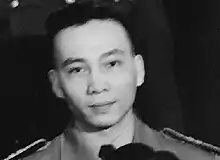Lữ Mộng Lan
Lieutenant General Lữ Mộng Lan (28 September 1927 – 28 May 2021) served in the Army of the Republic of Vietnam (ARVN).

Biography
Lữ was born in Quang Tri, Vietnam on 28 September 1927.
In 1944, he earned a Diplome D'Etudes Primaires Superieures Indochinoise (DEPSI), from Lycee Khai Dinh, located in Hue. In 1957, he graduated from Command and General Staff School, Fort Leavenworth.
Lữ served as Commander of II Corps and 2nd Tactical Zone (CTZ) since March 1, 1968. He also served as Company commander, 1951; Deputy Battalion commander, 1952; Regimental Chief of Staff, 1954; Division Chief of Staff, 1955; Deputy Chief of Staff for Operations, JGS, 1958; Commander, 25th Infantry Division, 1962; 23rd Infantry Division, 1964; 10th Infantry Division, 1965; - Chief, General Office of Military Instruction, JGS, 1966 and Commandant, Defense College, 1967. In 1970, he was a commander of II Corps in the Cambodian Campaign.
By the end of 1965 the US advisers to the 10th Division regarded General Lan as "moody and vacillatory" and "a marginal commander who would have to be worked with." They gave Lan high marks for his "perceptiveness and dexterity in civil affairs and troop morale" but saw his interest in local politics as too distracting. Although they found his three regimental commanders "capable and willing people," they felt that it was too early to judge if the Division was going to jell into a fighting unit. COMUSMACV General William Westmoreland predicted that combined operations with the US 1st Infantry Division and the 173rd Airborne Brigade would inspire the Division to higher standards.[1]: 115–6 In 1968 But he succeeded Nguyễn Phước Vĩnh Lộc as II Corps commander, he was not necessarily regarded as an improvement by MACV. As commander of the 25th, 23rd and 18th Infantry Divisions between 1962 and 1966, he had received poor ratings from almost all of his American advisers, and, since September 1966, had served as the deputy chief of staff for training and director of the Central Training Command. He was, however, an ardent Thiệu supporter and could be expected to follow the dictates of the Saigon government more closely than his predecessor.[1]: 309
Awards and decorations
National honours
 Commander of the National Order of Vietnam
Commander of the National Order of Vietnam Army Distinguished Service Order, First Class
Army Distinguished Service Order, First Class Air Force Distinguished Service Order, Second Class
Air Force Distinguished Service Order, Second Class Navy Distinguished Service Order, Second Class
Navy Distinguished Service Order, Second Class Gallantry Cross (10 with palm, 2 with gold star, 1 with silver star, 1 with bronze star)
Gallantry Cross (10 with palm, 2 with gold star, 1 with silver star, 1 with bronze star) Air Gallantry Cross Gold Wing Ribbon
Air Gallantry Cross Gold Wing Ribbon Hazardous Service Medal
Hazardous Service Medal Leadership Medal
Leadership Medal Armed Forces Honor Medal, First Class
Armed Forces Honor Medal, First Class Staff Service Medal, Second Class
Staff Service Medal, Second Class Civil Actions Medal, Second Class
Civil Actions Medal, Second Class Training Service Medal, Second Class
Training Service Medal, Second Class Good Conduct Medal, Fifth class
Good Conduct Medal, Fifth class Vietnam Campaign Medal
Vietnam Campaign Medal Military Service Medal, Fifth class
Military Service Medal, Fifth class Chuong My Medal, First Class
Chuong My Medal, First Class
Foreign honours
 Thailand :
Thailand :
_ribbon.svg.png.webp) Knight Commander of the Order of the White Elephant
Knight Commander of the Order of the White Elephant
 South Korea :
South Korea :
 Order of Military Merit, Eulji Medal
Order of Military Merit, Eulji Medal
References
- Clarke, Jeffrey (1998). The U.S. Army in Vietnam Advice and Support: The Final Years, 1965-1973 (PDF). U.S. Army Center of Military History. ISBN 978-1518612619.
 This article incorporates text from this source, which is in the public domain.
This article incorporates text from this source, which is in the public domain. - "Tưởng nhớ Trung Tướng Lữ Lan". Hon-viet. Retrieved 26 March 2023.
Further reading
- Ott, Major General Daid Ewing (1975). "Vietnamization, November 1969-February 1973 (193)". Field Artillery 1954-1973. Vietnam Studies. Department of the Army. Archived from the original on 2021-12-19. Retrieved 2010-08-17.